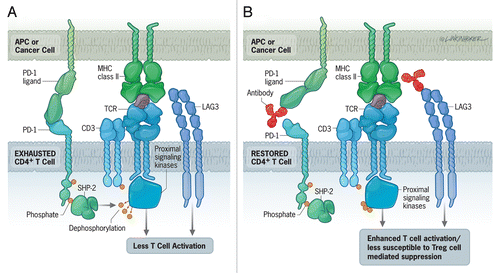Figures & data
Figure 1. Combinatorial immunotherapeutic approaches for the treatment of recurrent tumors. (A) Interaction of the inhibitory receptors PD-1 and LAG-3 on CD4+ T cells with PD-L1 and MHC class II molecules, respectively, on antigen-presenting cells (APCs) and tumor cells leads to the de-phosphorylation of the T-cell receptor (TCR) and T-cell exhaustion. This corresponds to a robust decrease in T-cell proliferation, cytokine production and cytotoxic activity. (B) PD-L1-blocking antibodies reinvigorate T-cell activity (at least in part) by restoring TCR phosphorylation, while the blockade of LAG-3 either inhibits the immunosuppressive functions of regulatory T cells (Tregs) in a direct fashion or renders CD4+ effector T cells less susceptible to Tregs.
